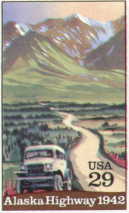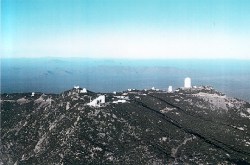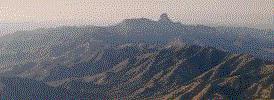
Home
Aviation Stories
"In Memory Of"
Net Sites
Sign Guestbook
View Guestbook
Email Ron

Nogales, Arizona, With The "Breakfast Club"
Regular AVweb contributor Ron Kilber gets up at oh-dark-thirty to fly copilot on a day trip to Nogales, Ariz., with Don Downin, a member of the 100-member-strong Phoenix-area "Breakfast Club," which has selected this tiny and modern international airport as a destination for its monthly hundred-dollar getaway. Situated in a mountainous region on the U.S.-Mexican border, Nogales International Airport is a quiet sanctuary with a marvelous little airport café that serves as a splendid venue for camaraderie and hangar flying.
by Ron Kilber (rpknet@aztec.asu.edu)
photography by Bob Shane (bobshane@usa.net)
Saturday, April 10, 1999
My clock radio has been blaring for 10 minutes, but I don't know it until the alarm buzzer sounds at 5:10 AM and wakes me. I'm so tired, I forgot why I set the darn thing last night, and all I want to do now is sleep some more -- a lot more. But when I remember that I'm going flying today, suddenly I'm wide awake, something I wouldn't be if I had to go to work, instead. So I get my act together and get ready to head for Falcon Field (FFZ) in Mesa, Arizona.
I've known of the 100-member-strong Breakfast Club (BC) and their monthly escapades for some time, but I've never had the opportunity to join them on any outing. Today, I've been invited to copilot for Don Downin who owns a meticulously maintained 1965 Piper PA-28 (aka Cherokee 140, Cruiser), and being no stranger to this bird myself, I think it ranks as one of the safest and toughest entry-level airplanes ever produced.
The club's destination today is Nogales, Arizona, 150 statute miles southeast from Mesa right on the US-Mexican border. It's a tiny but modern international airport situated in a high-desert, mountainous region west of the legendary towns of Tombstone and Bisbee. Nogales' airport is a quiet sanctuary compared to its downtown counterpart and Mexico's across-the-border sister, both of which are now the frequent subject of nightly TV news footage about illegal aliens, mile-long drug tunnels and La mordida ("the bite", Mexican Police accusing tourists -- usually Americans -- of some crime and then demanding payment.)
As I approach Don Downin's hangar at Falcon Field in Mesa, Arizona, sure enough and just as he said a week ago, he's already here. No need to call any pilot ahead of time to make sure the date is still on. Most of 'em I've know could've scheduled today's outing a year ago, and without any contact since, they'd show. Compared to some non-pilots and maybe all Gen-Xers today, you might never find a single one whose word is good, say, beyond five or ten minutes.
At 8:12 AM Falcon Tower clears us for takeoff on Runway 4-R, and within a minute, we're climbing in 54° (F) air above brand new Apache helicopters on Boeing's ramp in the shadow of Red Mountain. These combat aircraft may well be destined to NATO's current war effort in Europe in defense of tiny Kosovo from much larger Yugoslavia and its butcher dictator, Milosovic.
The Valley Of The Sun has lots of Class B airspace, not to mention airports, so after we jockey around for awhile, we're finally able to achieve a beeline heading of 148° compass to Nogales (OLS) while climbing to 7,500 feet above mean sea level (MSL). When we level off, Don's Apollo Global Positioning Sensor (GPS) says our ground speed is 148 miles per hour (MPH), owing to not only a little tail wind, but the many speed modifications installed on his plane. The air is calm and visibility is unlimited -- not at all unusual for Arizona.
Flight en route in 40° (F) air is uneventful, but as I learn is the case for each BC outing, one by one, members check in on Unicom frequency 122.75. First I hear "BC-1" check in. That's Warren McIlvoy, the club's organizer. Then "BC-8" checks in, followed by "BC-19" and "BC-7". Others follow suite, but being a new kid on the block, I don't yet have Don's benefit of associating names and faces with the monikers. Even so, it's a lot of fun as the pack grows.
Don tells me that members originate from every airport in the valley, but we won't know for sure just how many Breakfast Clubers there'll be today until after we land at Nogales.
Picacho Peak (3382 MSL) is off our right ring. It's the site of a civil war battle, which is well known around here for being the farthest west conflict of that war. The Picacho Pass Battle is re-enacted here each year during March.
Not far left is the infamous Biosphere where a human-captivity experiment went bad. There was a lot to gain from what they might've taught, but instead they fought. Proof you should never lock up a bunch of PhDs with a grant and too much time on their hands in a greenhouse.
We're over Pinal Air Park (MZJ) now. It's the home of Evergreen Air Center, which provides a full range of commercial aircraft services. If you're a banker with an airline client who just stiffed you on lease payments, for example, you might have your repo man deliver your 747 to Pinal for storage and safe-keeping. The red NEA L-1011 used in the movie, "Die Hard Two", was painted here. They even do aircraft demolition and have a boneyard (a good place to find an old fuselage if you're thinking about opening a wide-body restaurant on an airfield somewhere).
Within minutes we over-fly Old Tucson, which Columbia Pictures created in 1939 for the movie classic, "Arizona". It set the stage for the filming of many more westerns and TV serials such as "The Rifleman", "The High Chaparral", "Wagon Train", "Bonanza", "Gunsmoke" and "Have Gun Will Travel".
After an hour and twenty-two minutes en route, Don and I touch the numbers downhill on Runway 21 at Nogales International Airport (3370 MSL). We have to park in the over-flow area, so it appears we arrived at the tail end of the pack.Once we're inside the new and modern terminal, I'm surprised to learn that Larry Tiffen’s little café consists of an open room off the main terminal area. People are in queue waiting to place their breakfast order through a window to the kitchen. Others are seated already eating their food, while more are waiting for food to arrive at their tables. While it doesn't feel like a restaurant, the pilot food certainly looks and smells great.
Warren McIlvoy informs me that 20 members have showed up so far, arriving in 11 separate airplanes originating from five airports in the Phoenix area: Falcon Field, Scottsdale, Deer Valley, Carefree and Goodyear.
What do chateaubriand and steak 'n eggs at the Nogales Airport have in common? Both feed four. Don's the only one who orders steak, and he's the only one who can't finish all of his food.
After breakfast, Warren addresses the group with club business and news. Then he tells everyone a guest among them actually flew the North Atlantic in a WWII-era C-53 Skytrooper (aka DC-3, Gooney Bird, Dakota), which was restored in 1997 in Arizona for a Dutch museum, which is dedicated to honor those American Allies who fought for the liberation of The Netherlands. In fact, 1999 marks the 55th anniversary of Operation Market Garden (of "A Bridge Too Far" fame).
Turning to me, Warren asks, "Will you share some of your DC-3 adventures with everyone?"
Well, how do you get out of a pickle like this? You don't, and so while taking Warren's place in front of the group, someone blurbs out that they've never had a guest speaker before. This causes everyone to laugh and applaud, not so much because I'm their first to show-and-tell, but more so because it's patently obvious Warren has put me on the spot to talk extemporaneously. He set the stage, and now everyone is anticipating. Hey, I don't mind. I can tell hangar stories until everyone needs a bathroom break.
But it's a beautiful day outside and there's still more flying to do, so I keep my talk reasonably short. Besides, much of my Skytrooper account can be found on the Internet at http://aztec.asu.edu/dakota/story.html where it can be enjoyed during the evening in the comfort of one's home.
By noon, everyone has already said farewell, and Don and I are back in the air after departing downhill on Runway 21 (7200 feet). We decide to skirt the short distance south for a closer look at downtown Nogales.
My first impression is that the US-Mexico border these days looks like the Great Wall of China. The barrier extends for a few miles in either direction of the Nogales checkpoints. The only problem: what's to keep the determined border-jumper from entering Arizona à la hike-to-the-end-of-the-wall fashion? Nothing. I guess that's where the US Border Patrol comes in. They might well soon be the largest standing army in this country, but wouldn't if the wall were too long.
Well, we don't want to chance drifting into Mexico where we might get shot down, so we turn and head north. Don says he's not in any hurry to get home and we can go sight-seeing if I have the time. No argument there from me.

Kitt Peak National ObservatorySo we head northwest to Kitt Peak (6900 MSL). This is where they have the world's largest collection of optical telescopes, which are located high above the Sonoran Desert and away from artificial lights on the Tohono O'odham Reservation. Kitt Peak is not only home to twenty-two optical and two radio telescopes, but eight or so astronomy-research institutions, too.
The nearby Military Operations Area (MOA) is closed for the weekend, so there's no chance on this Saturday to get run over by any F-15 student pilot from Luke Air Force Base.

Baboquivari Peak (The Sacred Mountain)Baboquivari Peak (7740 MSL) is a short distance to the south, and it's a magnificent sentinel above the southern Arizona landscape. I'm sure it has been the best landmark for 100 miles in all directions for centuries. If it saved my life by helping me find water or my way, it'd be my sacred mountain, too.
Baboquivari is a popular rock-climbing destination for the back-country adventurer. I've had my own eye on it for years, but unless I pursue it pretty soon, I may never physically be able to summit the peak.
After skirting Kitt Peak Observatory, we head due-north to Mesa. The only problem, Eloy is now on our route, and it's where sky jumpers are quite busy today. The thought of shrouding Don's plane with a parachute doesn't enthrall us, so he suggests we divert for more sight-seeing. Again, no argument from me.
So we veer farther northwest to Rainbow Valley on the western side of the Sierra Estrella Mountains, where we spot a tow plane launching a glider. The up-drafts on the windward side must be incredible, because we can see the glider rapidly climbing higher and higher. Around here, only the lack of on-board oxygen prevents a pilot from exhausting his up-drafts.
Not a lot is happening in Rainbow Valley. Then again, not much can happen. It's mostly all barren desert from mountain to mountain.
As we travel northward, excitement pickups. There's a water-skiing community below, and a few people are taking advantage of the gorgeous, swim-suit weather.
Eventually, we need to turn easterly, and the Goodyear Tower grants permission to traverse their airspace. Off the right wing, there's a competition in progress at the Phoenix International Racetrack, but it appears from the sparse parking lot they have a shortage of spectators.
When we come up on Hanger Haciendas air park at the base of South Mountain, Don and I muse over the thought of how nice it'd be to live there. The runway seems a bit short, but it's nothing that couldn't be rectified with the purchase of a Husky or something for those high density-altitude days.
Thinking of air-park living, I've personally checked out many airports around Arizona. It's been in the back of my mind for years, and hopefully it may become a reality one day very soon. It's Don's desire, too, but as with all things in life, there are always the shackles and the costs.
Soon Don has us on final for Runway 22-L back at Falcon Field. After we clear the active runway, the temperature quickly rises in the cockpit, and we taxi back to the hangar with the door open.
But there are ways to deal with the mid-day heat in Arizona. Don has solved the problem by installing a hangar refrigerator, which is generously stocked with ice-cream bars. Boy, do they hit the spot right now. If it were already Miller Time, he might produce a couple of colds ones.
I've been on $100-breakfast flights more times than I can remember. But this one I'll never forget, made memorable and more lasting by the many wonderful new friends I've made today.
I'm glad my alarm clock woke me.
The End
A beautiful day in Nogales, Arizona
Today's participants:
(Not everyone is pictured)Warren & Jeri-Ann McIlvoy (Cherokee Warrior), Andrea Waas & Fitz Shelton (Cessna 172), Don Downin & Ron Kilber (Cherokee 140/160), Ray Onstine, Lois & Favre Eaton (Cherokee Archer), Richard Azimov & Dennis Bateman (Cessna 182), Bob & Ann Healey (Mooney), George Wilen (Beech T-34), Les Horrell (Beech TravelAir), Jerry Wyatt & Dawn Temper (Cessna 172), Greg Robinson & Fred Rockenhauser (Cardinal), and Ed Urbanik (Mooney)
For more information about the Breakfast Club, send some email to Warren McIlvoy at Warren.McIlvoy@asu.edu or visit the Breakfast Club's home base on the Internet at http://www.public.asu.edu/~idwlm where you can find trip reports and a schedule of up-coming destinations.
Ron Kilber is a private pilot with a passion for adventure, flying and airplanes. Contact Ron via email at rpknet@aztec.asu.edu.Bob Shane is a Phoenix-based professional photographer. His work has appeared in more than 100 aviation publications around the world. Bob's email address is bobshane@usa.net.